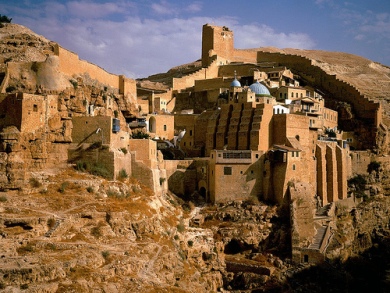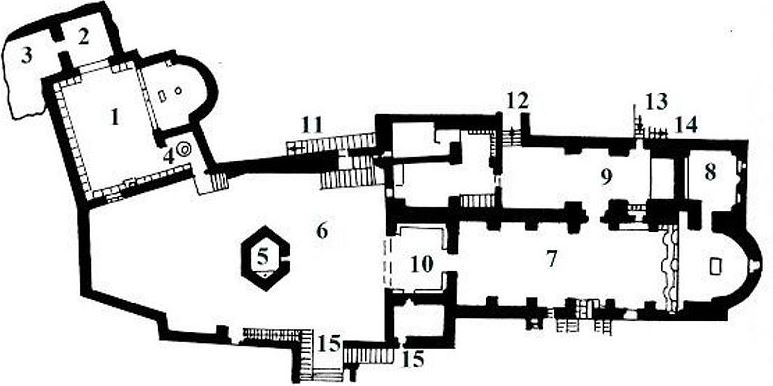

Mar Saba Monastery is one of the earliest Christian monasteries in the World. It is located 17 km (11 mi) East of Bethlehem in Israel.
Location: 17 km (11 mi) East of Bethlehem Map
Tel. (02) 277 3135
Open 8am- 5pm daily
No women allowed!
Mar Saba Monastery as it is locally known in Arabic is also known as the Holy Lavra of Saint Sabbas the Sanctified or simply Convent or Monastery of Saint Sabba. It is an enormous Greek Orthodox Monastery. Unlike many other religious complexes in the Middle East, Mar Saba Monastery was not completely demolished and many of its original parts have preserved despite centuries of erosion. The first such things are the towers of Justinian that is the first thing that you see when you approach the abbey. These military fortifications were constructed in the 5th century AD using donations of the great Byzantine Emperor Justinian I.
First monks escaped to these lands during Roman persecutions of Christians in the 3rd and 4th centuries AD, however these settlements were sporadic and disorganised. Mar Saba Monastery was officially found in 483 by Sabbas the Santified of Mutalaska that came here from Cappadocia in Turkey. He settled in the Judean Desert and constructed a church in a natural cave. His students began to settle in nearby caves as well. Around this time Emperor Justinian sent large sums of money to construct first walls and towers for the defense of the Christian community here. Records state that by the end of life Saint Sabbas (Saint Sava) the monastery had over 5000 monks.
Unfortunately Mar Saba Monastery didn't escape the fate of other monasteries and cities in the region. In 614 hordes of Persian invaders swept through the region. They killed most of people they encountered including the monks who lived here. Those who survived the massacre by hiding in the caves and crevices around the monastery returned and burried their bretheren in a tomb that is still preserved. Introductory chapter of "Pandects" are dedicated to martyrdom of Mar Saba Monastery monks that was witnessed by Antioch Palestinian.
In the 8th century Mar Saba Monastery became home to Saint John Damscene (From Damascus in Syria) who lived here for about 50 years. He became a famous writer and philosopher of the Eastern Orthodox Church. The cave where he lived as well as his tomb is still preserved and can be accessed with the permission of the monks who live here.
At the beginning of the 12th century Mar Saba Monastery was visited by the Russian pilgrim Abbot Daniel who left a detailed account about the community here:
Lavra of Saint Sava (Saba) is located in the valley of Jehoshaphat, in the vale of tears, which starts from Jerusalem, going from Gethsemane, the valley passes through the monastery and reaches the Sea of Sodom (The Dead Sea). Lavra of Saint Sava was arranged by God in a wonderful and inexpressible in words. Tech stream that once was terrible and very deep now dried out. Its cliffs are high and on those cliffs brothers built their cells on both sides of the gorge like the stars in the sky. There are three churches. Among the cells of the West there is wonderful cave under a rock stone and this cave houses a cave church of Saint Mary.
Keep in mind that Mar Saba Monastery has restrictions for outsiders and particularly women. Mar Saba is a male monastery so women are not allowed on most of the area. The only place where they can enter is so called Women's Tower near the main entrance to the religious complex.
Layout of Mar Saba Monastery

|
1. Church of Saint Nicholas 2. Treasury 3. Ossuary 4. Baptistery 5. Chapel, resting place of Saint Sava (Saba) 6. Courtyard with burial loculi |
7. Cathedral of the Annunciation 8. Treasury 9. North Chapel 10. Narthex 11.Staircase to the upper entrance of the monastery 12. Passageway to the North part of the monastery |
13. Staircase to the refectory 14. Staircase to the lookout 15. Passageway to the South cells |